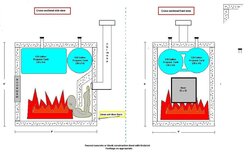Dave, I don't know if it will help you or not, but I am attaching the .pdf for my refractory. I also noticed when I dug up the email, I paid $48 for a 55# bag of this.
Edit, can't post .pdf so I will c/p the file.
II I
Product Data 02/09: 5976
Page 1 of 2
MIZZOU® CASTABLE PLUS
Description: 3000°F High-Alumina Castable
Features: • Excellent resistance to numerous slags.
• Resists vitrification.
• Shows expansion rather than shrinkage at high temperatures.
• Superior resistance to spalling.
• High strength throughout its entire temperature range.
Uses: • Combustion chambers.
• Low-temperature incinerators.
• Air heaters, boilers, and burner blocks.
• Aluminum furnace upper sidewalls and roof regions.
• Forge furnaces and iron foundry ladles.
Chemical Analysis: Approximate (Calcined Basis)
Silica (SiO2) 32.6%
Alumina (Al2O3) 60.6%
Iron Oxide (Fe2O3) 1.2%
Titania (TiO2) 2.2%
Lime (CaO) 2.6%
Magnesia (MgO) 0.3%
Alkalies (Na2O+K2O) 0.5%
Physical Data (Typical)
Maximum Service Temperature 3000°F (1650°C)
Material Required 141 lb/ft3 (2.26 g/cm3)
Bulk Density
After 220°F (105°C)
After 1500°F (815°C)
lb/ft3 (g/cm3)
145 (2.32)
141 (2.26)
Modulus of Rupture
After 220°F (105°C)
After 1500°F (815°C)
After 2000°F (1095°C)
After 2500°F (1370°C)
lb/in.2 (MPa)
1,200 (8.3)
800 (5.5)
600 (4.1)
1,100 (7.6)
Cold Crushing Strength
After 220°F (105°C)
After 1500°F (815°C)
After 2000°F (1095°C)
After 2500°F (1370°C)
lb/in.2 (MPa)
5,500 (37.9)
3,500 (24.1)
3,000 (20.7)
4,000 (27.6)
Permanent Linear Change
After 220°F (105°C)
After 1500°F (815°C)
After 2000°F (1095°C)
After 2500°F (1370°C)
After 2900°F (1595°C)
-0.1%
-0.2%
-0.2%
+0.9%
+2.8%
Product Data
Page 2 of 2
MIZZOU® CASTABLE PLUS
Thermal Conductivity
At 400°F (205°C)
At 800°F (425°C)
At 1200°F (650°C)
At 1600°F (870°C)
At 2000°F (1095°C)
At 2400°F (1315°C)
Btu·in/hr·ft2·°F (W/m·°C)
7.8 (1.12)
7.7 (1.11)
7.6 (1.10)
7.5 (1.08)
7.4 (1.07)
7.4 (1.07)
Particle Size
Maximum Grain Size 4 Mesh (Tyler)
Less than 5%
Note: The test data shown are based on average results on production samples and are subject to normal variation on individual tests. The test
data cannot be taken as minimum or maximum values for specification purposes. ASTM test procedures used when applicable.
Mixing and Using Instructions (Water calculated at 8.337 lb/gallon) 55 lb bag 1000 lb bag 1500 lb bag
Water Required—Vibration Casting (Weight 8.6%)
Pounds
Gallons
Liters
4.7
0.6
2.1
86.0
10.3
39.0
129.0
15.5
58.5
Water Required—Hand Casting/Pouring (Weight 9.1%)
Pounds
Gallons
Liters
5.0
0.6
2.3
91.0
10.9
41.2
136.5
16.4
61.9
Working Time 20 minutes
For detailed mixing and using instructions, contact your ANH representative or visit
www.anhrefractories.com.
Heatup/Dryout Schedule
See ANH Dryout Schedule 2—PLUS Rated Castables and Gunning Castables.
Installation Guidelines
See ANH Installation Guidelines CC-1—Conventional Castables—Standard.
Shelf Life (Under Proper Storage Conditions) 365 days


